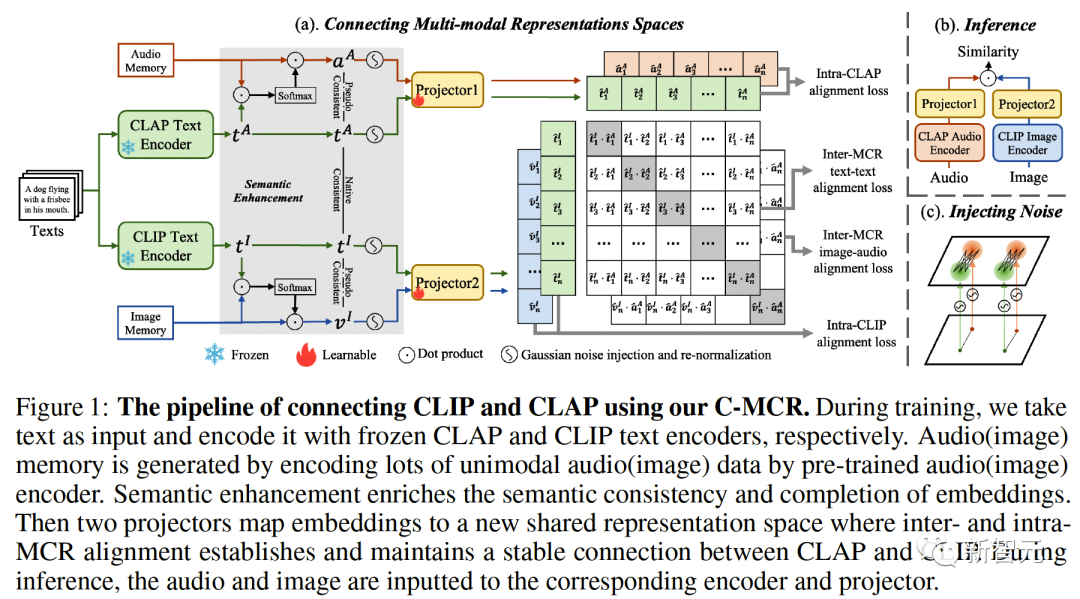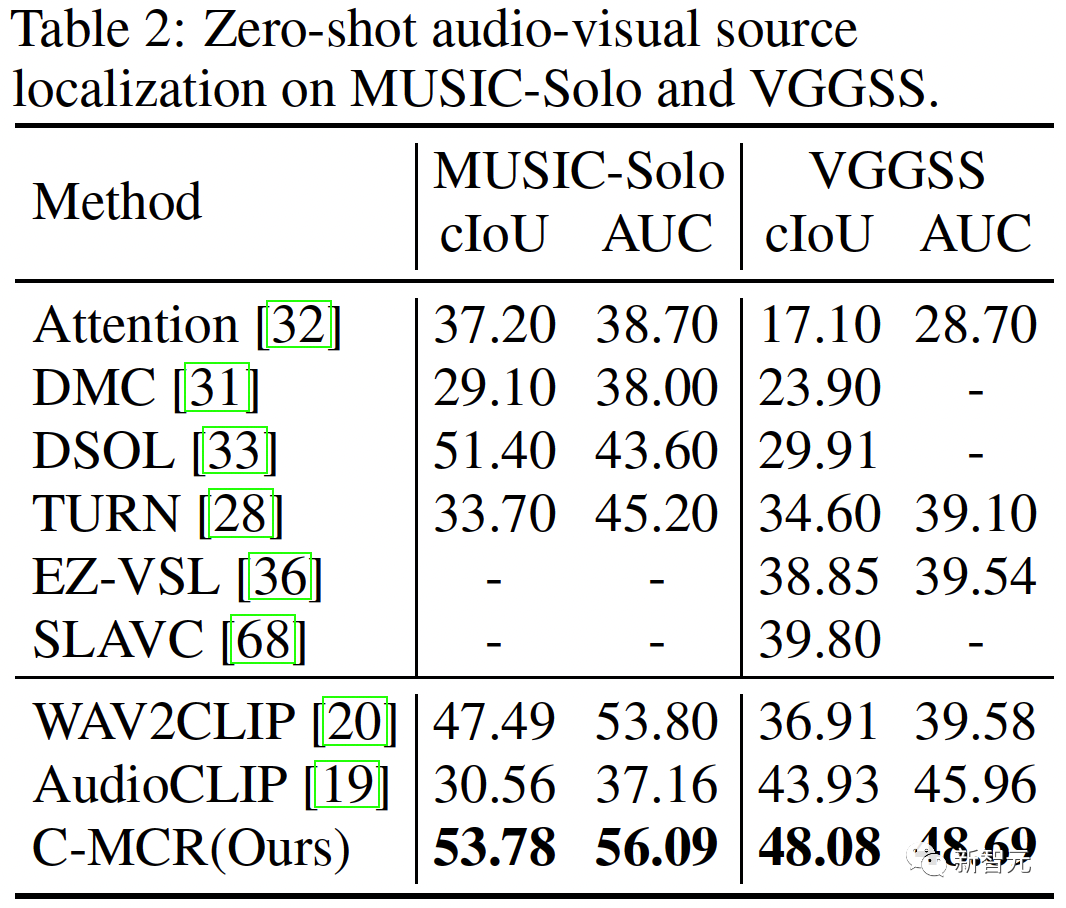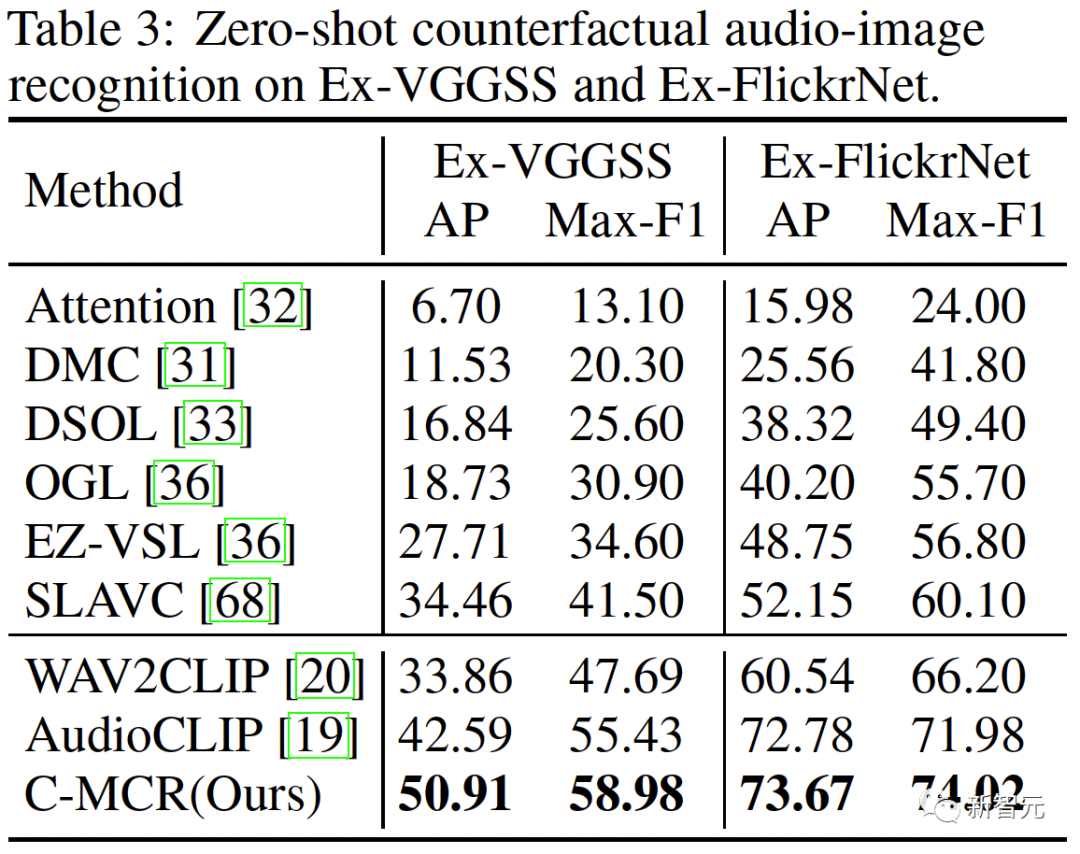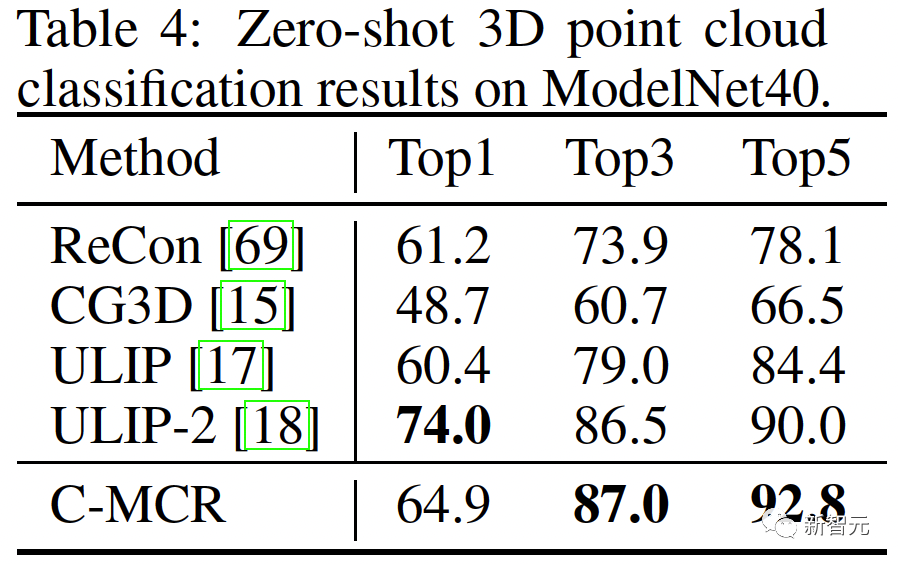 Technology peripherals
Technology peripherals
 AI
AI
 You can learn 'without matching data'! Zhejiang University and others proposed connecting multi-modal contrast representation C-MCR
You can learn 'without matching data'! Zhejiang University and others proposed connecting multi-modal contrast representation C-MCR
You can learn 'without matching data'! Zhejiang University and others proposed connecting multi-modal contrast representation C-MCR
Multimodal contrastive representation (MCR) aims to encode inputs from different modalities into a semantically aligned shared space
As the visual-linguistic domain With the great success of the CLIP model, more and more modal contrast representations have begun to emerge and have achieved significant improvements in many downstream tasks, but these methods rely heavily on large-scale and high-quality paired data
In order to solve this problem, researchers from Zhejiang University and other institutions proposed Concatenated Multimodal Contrast Representation (C-MCR), a multimodal contrastive representation learning method that does not require paired data and is extremely efficient in training.

Please click the following link to view the paper: https://arxiv.org/abs/2305.14381
C-MCR project homepage link: https://c-mcr.github.io/C-MCR/
Model and code address: https://github.com/MCR -PEFT/C-MCR
This method connects different pre-trained contrastive representations through hub modalities without using any paired data, and we learn powerful audio-visual and 3D point cloud-text representation, and achieved SOTA effects on multiple tasks such as audio-visual retrieval, sound source localization, and 3D object classification.
Introduction
Multimodal contrastive representation (MCR) aims to map data from different modalities into a unified semantic space. With the great success of CLIP in the visual-linguistic field, learning contrastive representations between more modal combinations has become a hot research topic, attracting more and more attention.
However, the generalization ability of existing multimodal contrastive representations mainly benefits from a large number of high-quality data pairs. This severely limits the development of contrastive representations on modalities that lack large-scale high-quality data. For example, the semantic correlation between audio and visual data pairs is often ambiguous, and paired data between 3D point clouds and text are scarce and difficult to obtain.
However, we have observed that these modal combinations that lack paired data often have a large amount of high-quality paired data with the same intermediate modality. For example, in the audio-visual domain, although the quality of audiovisual data is unreliable, there is a large amount of high-quality paired data between audio-text and text-visual.
Similarly, while the availability of 3D point cloud-text pairing data is limited, 3D point cloud-image and image-text data are abundant. These hub modes can establish further links between modes.
Considering that modalities with a large amount of paired data often already have pre-trained contrastive representations, this article directly attempts to connect the contrastive representations between different modalities through the hub modality. Thus, a new contrastive representation space is constructed for modal combinations lacking paired data.
Using Concatenated Multimodal Contrast Representation (C-MCR), you can build connections with a large number of existing multimodal contrastive representations through overlapping modes, thereby learning a wider range of modalities. alignment relationship between them. This learning process does not require any paired data and is extremely efficient
C-MCR has two key advantages:
The focus is on flexibility:
The ability of C-MCR is to provide contrasting representations that lack direct pairing for modal learning. From another perspective, C-MCR treats each existing multi-modal contrast representation space as a node, and overlapping modes as key hub modes
By connecting individual isolated multimodal contrastive representations, we are able to flexibly extend the obtained multimodal alignment knowledge and mine a wider range of intermodal contrastive representations
2. Efficiency:
Since C-MCR only needs to build connections for the existing representation space, it only needs to learn two simple mappers. Training parameters and training costs are extremely low.
In this experiment, we use text as a hub to compare visual-text (CLIP) and text-audio (CLAP) to represent spatial connections, and finally get high-quality The visual-audio representation
Similarly, by comparing the image-connected text-visual (CLIP) and the visual-3D point cloud (ULIP) to represent the space, a set of 3D Point Cloud-Text Contrast Representation
Method
Figure 1 (a) Introduces the algorithm flow of C-MCR (taking the use of text to connect CLIP and CLAP as an example) .

The data of text (overlapping modalities) are encoded into text features by the text encoders of CLIP and CLAP respectively:,.
At the same time, there is also a large amount of unpaired single-modal data that is encoded into CLIP and CLAP spaces respectively, forming image memory and audio memory
Feature semantic enhancement refers to the process of improving and optimizing features to enhance their semantic expression capabilities. By appropriately adjusting the features, it can more accurately reflect the meaning to be expressed, thereby improving the effect of language expression. Feature semantic enhancement technology has important application value in the field of natural language processing, which can help machines understand and process text information, and improve machine capabilities in semantic understanding and semantic generation
We can start by improving the semantic information of representation to enhance the robustness and comprehensiveness of spatial connections. In this regard, we first discuss it from the two perspectives of semantic consistency and semantic integrity
Inter-modal semantic consistency
CLIP and CLAP have learned reliable aligned image-text and text-audio representations respectively.
We exploit this inherent modal alignment in CLIP and CLAP to generate image and audio features that are semantically consistent with the i-th text, thereby better quantifying contrast in the representation space Modality gap and more direct mining of correlations between non-overlapping modalities:

Intra-modal semantic integrity
Different representation spaces will have different tendencies for the semantic expression of data, so the same text in different spaces will inevitably have semantic deviations and losses. This semantic bias is accumulated and amplified when connecting representation spaces.
To enhance the semantic completeness of each representation, we propose to add zero-mean Gaussian noise to the representations and renormalize them to the unit hypersphere:

As shown in Figure 1 (c), in the contrastive representation space, each representation can be seen to represent a point on the unit hypersphere. Adding Gaussian noise and renormalizing allows the representation to represent a circle on the unit sphere.
When the spatial distance between two features is closer, their semantic similarity is higher. Therefore, the features within the circle have similar semantics, and the circle can express the semantics more completely
2. Alignment of Inter-MCR
After representation semantic enhancement, we use two mappers and to remap CLIP and CLAP representations to a new shared space

The new space needs to ensure that semantically similar representations from different spaces are close to each other.
( ,
, ) derived from the same text are naturally semantically consistent and can be regarded as real tag pairs, while those derived from (
) derived from the same text are naturally semantically consistent and can be regarded as real tag pairs, while those derived from ( ,
, ) of (
) of ( ,
, ) can be regarded as pseudo-label pairs . The semantics between
) can be regarded as pseudo-label pairs . The semantics between
( ,
, ) are highly consistent, but the connections learned from them are not suitable for audio -Indirectly speaking. Although the semantic consistency of the (
) are highly consistent, but the connections learned from them are not suitable for audio -Indirectly speaking. Although the semantic consistency of the ( ,
, ) pair is less reliable, it is more directly beneficial to audio-visual representation.
) pair is less reliable, it is more directly beneficial to audio-visual representation.
In order to connect the two contrastive representation spaces more comprehensively, we simultaneously align ( ,
, ) and (
) and ( ,
, ):
):

##3. Alignment of Intra-MCR
In addition to the connection between spaces, there is also a modality gap phenomenon within the contrast representation space. That is, in the contrastive representation space, although the representations of different modalities are semantically aligned, they are distributed in completely different subspaces. This means that the more stable connections learned from ( ,
, ) may not be well inherited by audio-visual.
) may not be well inherited by audio-visual.
To solve this problem, we propose to realign the different modal representations of each contrastive representation space. Specifically, we remove the negative example exclusion structure in the contrast loss function to derive a loss function for reducing the modality gap. A typical contrastive loss function can be expressed as:

After we eliminate the negative pair exclusion term, the final formula can be simplified as:

Experimentally, we obtained by using text to connect audio-text space (CLAP) and text-visual space (CLIP) Audio-visual representation, using image connection 3D point cloud-image space (ULIP) and image-text space (CLIP) to obtain 3D point cloud-text representation.
The results of zero-sample audio image retrieval on AVE and Flickr-SoundNet are as follows:

The zero-sample sound source localization results on MUSIC-Solo and VGGSS are as follows:

The zero-shot counterfactual audio image recognition results on Ex-VGGSS and Ex-FlickrNet are as follows:

zero- on ModelNet40 The shot 3D point cloud classification results are as follows:

The above is the detailed content of You can learn 'without matching data'! Zhejiang University and others proposed connecting multi-modal contrast representation C-MCR. For more information, please follow other related articles on the PHP Chinese website!

Hot AI Tools

Undresser.AI Undress
AI-powered app for creating realistic nude photos

AI Clothes Remover
Online AI tool for removing clothes from photos.

Undress AI Tool
Undress images for free

Clothoff.io
AI clothes remover

AI Hentai Generator
Generate AI Hentai for free.

Hot Article

Hot Tools

Notepad++7.3.1
Easy-to-use and free code editor

SublimeText3 Chinese version
Chinese version, very easy to use

Zend Studio 13.0.1
Powerful PHP integrated development environment

Dreamweaver CS6
Visual web development tools

SublimeText3 Mac version
God-level code editing software (SublimeText3)

Hot Topics
 Open source! Beyond ZoeDepth! DepthFM: Fast and accurate monocular depth estimation!
Apr 03, 2024 pm 12:04 PM
Open source! Beyond ZoeDepth! DepthFM: Fast and accurate monocular depth estimation!
Apr 03, 2024 pm 12:04 PM
0.What does this article do? We propose DepthFM: a versatile and fast state-of-the-art generative monocular depth estimation model. In addition to traditional depth estimation tasks, DepthFM also demonstrates state-of-the-art capabilities in downstream tasks such as depth inpainting. DepthFM is efficient and can synthesize depth maps within a few inference steps. Let’s read about this work together ~ 1. Paper information title: DepthFM: FastMonocularDepthEstimationwithFlowMatching Author: MingGui, JohannesS.Fischer, UlrichPrestel, PingchuanMa, Dmytr
 The world's most powerful open source MoE model is here, with Chinese capabilities comparable to GPT-4, and the price is only nearly one percent of GPT-4-Turbo
May 07, 2024 pm 04:13 PM
The world's most powerful open source MoE model is here, with Chinese capabilities comparable to GPT-4, and the price is only nearly one percent of GPT-4-Turbo
May 07, 2024 pm 04:13 PM
Imagine an artificial intelligence model that not only has the ability to surpass traditional computing, but also achieves more efficient performance at a lower cost. This is not science fiction, DeepSeek-V2[1], the world’s most powerful open source MoE model is here. DeepSeek-V2 is a powerful mixture of experts (MoE) language model with the characteristics of economical training and efficient inference. It consists of 236B parameters, 21B of which are used to activate each marker. Compared with DeepSeek67B, DeepSeek-V2 has stronger performance, while saving 42.5% of training costs, reducing KV cache by 93.3%, and increasing the maximum generation throughput to 5.76 times. DeepSeek is a company exploring general artificial intelligence
 KAN, which replaces MLP, has been extended to convolution by open source projects
Jun 01, 2024 pm 10:03 PM
KAN, which replaces MLP, has been extended to convolution by open source projects
Jun 01, 2024 pm 10:03 PM
Earlier this month, researchers from MIT and other institutions proposed a very promising alternative to MLP - KAN. KAN outperforms MLP in terms of accuracy and interpretability. And it can outperform MLP running with a larger number of parameters with a very small number of parameters. For example, the authors stated that they used KAN to reproduce DeepMind's results with a smaller network and a higher degree of automation. Specifically, DeepMind's MLP has about 300,000 parameters, while KAN only has about 200 parameters. KAN has a strong mathematical foundation like MLP. MLP is based on the universal approximation theorem, while KAN is based on the Kolmogorov-Arnold representation theorem. As shown in the figure below, KAN has
 Hello, electric Atlas! Boston Dynamics robot comes back to life, 180-degree weird moves scare Musk
Apr 18, 2024 pm 07:58 PM
Hello, electric Atlas! Boston Dynamics robot comes back to life, 180-degree weird moves scare Musk
Apr 18, 2024 pm 07:58 PM
Boston Dynamics Atlas officially enters the era of electric robots! Yesterday, the hydraulic Atlas just "tearfully" withdrew from the stage of history. Today, Boston Dynamics announced that the electric Atlas is on the job. It seems that in the field of commercial humanoid robots, Boston Dynamics is determined to compete with Tesla. After the new video was released, it had already been viewed by more than one million people in just ten hours. The old people leave and new roles appear. This is a historical necessity. There is no doubt that this year is the explosive year of humanoid robots. Netizens commented: The advancement of robots has made this year's opening ceremony look like a human, and the degree of freedom is far greater than that of humans. But is this really not a horror movie? At the beginning of the video, Atlas is lying calmly on the ground, seemingly on his back. What follows is jaw-dropping
 AI subverts mathematical research! Fields Medal winner and Chinese-American mathematician led 11 top-ranked papers | Liked by Terence Tao
Apr 09, 2024 am 11:52 AM
AI subverts mathematical research! Fields Medal winner and Chinese-American mathematician led 11 top-ranked papers | Liked by Terence Tao
Apr 09, 2024 am 11:52 AM
AI is indeed changing mathematics. Recently, Tao Zhexuan, who has been paying close attention to this issue, forwarded the latest issue of "Bulletin of the American Mathematical Society" (Bulletin of the American Mathematical Society). Focusing on the topic "Will machines change mathematics?", many mathematicians expressed their opinions. The whole process was full of sparks, hardcore and exciting. The author has a strong lineup, including Fields Medal winner Akshay Venkatesh, Chinese mathematician Zheng Lejun, NYU computer scientist Ernest Davis and many other well-known scholars in the industry. The world of AI has changed dramatically. You know, many of these articles were submitted a year ago.
 The vitality of super intelligence awakens! But with the arrival of self-updating AI, mothers no longer have to worry about data bottlenecks
Apr 29, 2024 pm 06:55 PM
The vitality of super intelligence awakens! But with the arrival of self-updating AI, mothers no longer have to worry about data bottlenecks
Apr 29, 2024 pm 06:55 PM
I cry to death. The world is madly building big models. The data on the Internet is not enough. It is not enough at all. The training model looks like "The Hunger Games", and AI researchers around the world are worrying about how to feed these data voracious eaters. This problem is particularly prominent in multi-modal tasks. At a time when nothing could be done, a start-up team from the Department of Renmin University of China used its own new model to become the first in China to make "model-generated data feed itself" a reality. Moreover, it is a two-pronged approach on the understanding side and the generation side. Both sides can generate high-quality, multi-modal new data and provide data feedback to the model itself. What is a model? Awaker 1.0, a large multi-modal model that just appeared on the Zhongguancun Forum. Who is the team? Sophon engine. Founded by Gao Yizhao, a doctoral student at Renmin University’s Hillhouse School of Artificial Intelligence.
 Kuaishou version of Sora 'Ke Ling' is open for testing: generates over 120s video, understands physics better, and can accurately model complex movements
Jun 11, 2024 am 09:51 AM
Kuaishou version of Sora 'Ke Ling' is open for testing: generates over 120s video, understands physics better, and can accurately model complex movements
Jun 11, 2024 am 09:51 AM
What? Is Zootopia brought into reality by domestic AI? Exposed together with the video is a new large-scale domestic video generation model called "Keling". Sora uses a similar technical route and combines a number of self-developed technological innovations to produce videos that not only have large and reasonable movements, but also simulate the characteristics of the physical world and have strong conceptual combination capabilities and imagination. According to the data, Keling supports the generation of ultra-long videos of up to 2 minutes at 30fps, with resolutions up to 1080p, and supports multiple aspect ratios. Another important point is that Keling is not a demo or video result demonstration released by the laboratory, but a product-level application launched by Kuaishou, a leading player in the short video field. Moreover, the main focus is to be pragmatic, not to write blank checks, and to go online as soon as it is released. The large model of Ke Ling is already available in Kuaiying.
 The U.S. Air Force showcases its first AI fighter jet with high profile! The minister personally conducted the test drive without interfering during the whole process, and 100,000 lines of code were tested for 21 times.
May 07, 2024 pm 05:00 PM
The U.S. Air Force showcases its first AI fighter jet with high profile! The minister personally conducted the test drive without interfering during the whole process, and 100,000 lines of code were tested for 21 times.
May 07, 2024 pm 05:00 PM
Recently, the military circle has been overwhelmed by the news: US military fighter jets can now complete fully automatic air combat using AI. Yes, just recently, the US military’s AI fighter jet was made public for the first time and the mystery was unveiled. The full name of this fighter is the Variable Stability Simulator Test Aircraft (VISTA). It was personally flown by the Secretary of the US Air Force to simulate a one-on-one air battle. On May 2, U.S. Air Force Secretary Frank Kendall took off in an X-62AVISTA at Edwards Air Force Base. Note that during the one-hour flight, all flight actions were completed autonomously by AI! Kendall said - "For the past few decades, we have been thinking about the unlimited potential of autonomous air-to-air combat, but it has always seemed out of reach." However now,





